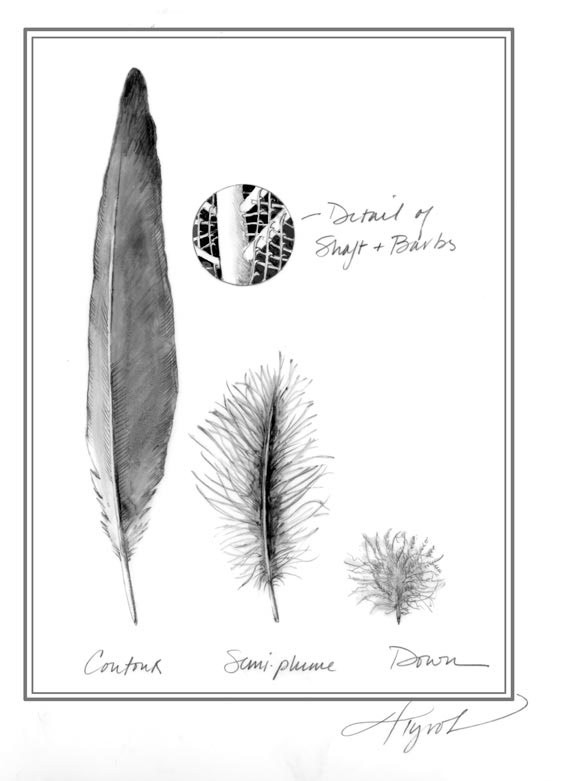
A New England January would be hard to bear without that winter essential: the puffy down jacket. It’s a great accessory for leisurely walks, but when we exert ourselves and speed up the pace, a down jacket quickly gets too hot. Wouldn’t it be nice to have a jacket with adjustable insulation, plus wind and waterproofing? Well, birds have all of that in their plumage, thanks to those amazing structures called feathers - the same material with which we stuff our jackets. On birds, though, these feathers are deployed with far greater finesse.
Feathers are arguably the most complex of all vertebrate skin coverings and are an outstanding example of evolutionary innovation. Light, strong, and durable, they perform many different functions for birds and the structures of feathers are diversified to suit their various roles. Feathers are shaped as airfoils for flight, fluffed for insulation, or smoothed and overlapped for weatherproofing. The latter two qualities allow birds to survive extraordinary cold, from the minus 25oF of a New England winter night to the unimaginable minus 75oF endured by emperor penguins in Antarctica.
When you look at a bird, what you see are the feathers known as contour feathers, the outermost layer of the bird’s plumage. Each feather is composed of a hollow shaft from which sprout on either side hundreds of fine, parallel branches, called barbs. Like a fractal pattern, each barb also has side branches, or barbules. Every barbule is equipped with a series of minute hooks along one side, which lock into a groove in the adjoining barbule. When all the barbules are locked together they create a smooth, water repellant surface, known as the feather’s vane. If hooks and grooves get separated they are easily repaired; the bird simply draws the vane through its beak. Countless overlapping contour feathers keep out the wind and weather and give birds their aerodynamic shape.
But there’s more beneath that smooth surface. Many contour feathers have a second feather attached to their base. These are known as semiplumes, and unlike contour feathers, most of their barbs are loose and fluffy and don’t interlock. Only the tip resembles the vane of a contour feather. The job of semiplumes is to plump out the contour feathers and provide insulation, while their small vanes fill any spaces between contours. Semiplumes also clothe the bird’s skin in tight anatomical spaces, such as the bases of wings, because they are highly flexible.
Down, the highly prized fill of quality jackets, forms the insulating undercoat of a bird’s plumage. Down is radically different from other feathers, having only a tiny shaft topped with a head of fluffy, springy barbs that do not zipper together and thus are able to trap a lot of air. Down is particularly well-developed in water birds like ducks and geese that spend a great amount of time with breasts and bellies submerged. We are familiar with the word “eiderdown,” which has come to mean a down comforter, but originated from the down of the seagoing eider duck. Eiders often nest on exposed shorelines. To keep incubating eggs warm, female eiders pluck out their breast down to line the nest.
The intricate organization of feathers continues at the chemical level.
Feathers are built from a specialized protein called beta-keratin. This is a sheet-like structure bonded tightly together by sulphur atoms, which are the source of the unpleasant smell when feathers are burned. The dense framework of beta-keratin makes feathers strong yet springy and accounts for the fact that a down jacket can be stuffed into a pocket, yet puff right up again when unpacked.
On very cold days, birds look puffy and fluffed-up, yet on mild winter days they look quite sleek. Birds can vary the loft of their plumage because their feathers are connected to sheets of muscle within the skin, known as erector muscles. When the weather calls for extra insulation, the erector muscles pull the feathers into a more upright position. This allows the down to expand and trap more air to increase the insulation value of the plumage.
The complexity of feather structure leads one to wonder why and how they would have evolved. The theory was that feathers evolved for flight. However, in 1997, the fossil of a dinosaur bearing primitive tube-like feathers was unearthed in northern China. Subsequent fossils showed a group of related dinosaurs with feathers ranging from down to contour-like, yet their skeletons were completely unsuited to flight. One can only speculate why earthbound dinosaurs had feathers. Was it for camouflage, or insulation? Maybe, like that puffed-up chickadee at the bird feeder, they survived – and thrived – through keeping warm.

